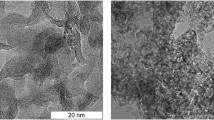Abstract
This paper presents the comparative analysis of the results of more than fifty experiments on measuring the electrical conductivity of detonation products of RDX, HMX, PETN, TNT, and TATB-based explosives. It is revealed that there is a correlation between the electrical conductivity and the mass fraction of carbon both in the chemical spike and at the Chapman–Jouguet point.
Similar content being viewed by others
References
B. Hayes, “Electrical Measurements in Reaction Zones of High Explosives,” in Proc. 10th Symp. (Int.) On Combustion, Cambridge, England, 1964 (Combustion Inst, Pittsburgh, PA, 1965).
B. Hayes, “On the Electrical Conductivity in Detonation Products,” in Proc. 4th Symp. (Int.) on Detonation (Office of Naval Research, 1967), ACR-126, pp. 595–601.
A. P. Ershov, N. P. Satonkina, and G.M. Ivanov, “Electrical Conductivity Profiles in Dense Explosives,” Chem. Phys. 26 (12), 1–13 (2007).
V. V. Danilenko, “Specific Features of Synthesis of Detonation Nanodiamonds,” Fiz. Goreniya Vzryva 41 (5), 104–116 (2005) [Combust., Expl., Shock Waves 41 (5), 577–588 (2005)].
A. P. Ershov, N. P. Satonkina, and G.M. Ivanov, “Electrical Conductivity Distribution in the Detonation of Pressed Explosives,” Pis’ma Zh. Tekh. Fiz. 30 (24), 63–69 (2004).
A. P. Ershov and N. P. Satonkina, “Investigation of the Reaction Zone in Heterogeneous Explosives Substances Using an Electrical Conductivity Method,” Fiz. Goreniya Vzryva 45 (2), 109–115 (2005) [Combust., Expl., Shock Waves 45 (2), 205–210 (2005)].
A. P. Ershov and N. P. Satonkina, “Electrical Conductivity Distributions in Detonating Low-Density Explosives—Grain Size Effect,” Combust. Flame 157 (5), 1022–1026 (2010).
N. P. Satonkina and I. A. Rubtsov, “Electrical Conductivity Distribution in the Detonation of TATB-Based Explosives,” Zh. Tekh. Fiz. 86 (1), 144–147 (2016).
K. Tanaka, Detonation Properties of Condensed Explosives Computed Using the Kihara–Hikita–Tanaka Equation of State (National Chem. Lab. for Industry, Tsukuba, Japan, 1983).
N. P. Satonkina, A. P. Ershov, E. R. Pruuel, and D. I. Karpov, “Electric Conductivity of Detonating Trotyl at Different Initial Conditions,” in Proc. XXIX Int. Conf. Physics of Extreme States of Matter (2014).
A. P. Ershov, N. P. Satonkina, O. A. Dibirov, S. V. Tsykin, and Yu. V. Yanilkin “A Study of the Interaction Between the Components of Heterogeneous Explosives by the Electrical-Conductivity Method,” Fiz. Goreniya Vzryva 36 (5), 97–108 (2000) [Combust., Expl., Shock Waves 36 (5), 639–649 (2000)].
M. M. Gorshkov, K. F. Grebenkin, A. L. Zherebtsov, V. T. Zaikin, V. M. Slobodenyukov, and O. V. Tkachev, “Kinetics of Electrical Conductivity of TATB Detonation Products As an Indicator of Growth of Carbon Nanoparticles,” Fiz. Goreniya Vzryva 43 (1), 92–98 (2007) [Combust., Expl., Shock Waves 43 (5), 78–83 (2007)].
S. D. Gilev, “The Use of the Electrical-Conductivity Method for the Study of Physical and Chemical Transformations in Detonation Waves,” in VI Zababakhin Scientific Readings, Proc. Int. Conf. [Inst. Tech. Phys. (VNIITF), Snezhinsk, 2001]; http://www.vniitf.ru/rig/konfer/6zst/dokl/sec2/3.pdf.
S. D. Gilev, “Electrodynamic Processes in Shock Compression of Condensed Matter,” Doct. Dissertation in Phys. and Math. Sci. (Lavrentyev Institute of Hydrodynamics, Sib. Branch, Russian Acad. of Sci., Novosibirsk, 2009) [in Russian].
D. G. Tasker and R. J. Lee, “The Measurement of Electrical Conductivity in Detonating Condensed Explosives,” in Proc. 9th Symp. (Int.) on Detonation (Office of Naval Research, 1989).
O. Breusov, “On the Mechanism of Dynamic Diamond Synthesis of Organic Substances,” Khim. Fiz. 21 (11), 110–112 (2002).
V. F. Anisichkin, “Mechanism of Carbon Release During Detonation Decomposition of Substances,” Fiz. Goreniya Vzryva 30 (5), 100–106 (1994) [Combust., Expl., Shock Waves 30 (5), 667–673 (1994)].
V. F. Anisichkin, “Isotope Studies of Detonation Mechanisms of TNT, RDX, and HMX,” Fiz. Goreniya Vzryva 43 (5), 96–103 (2007) [Combust., Expl., Shock Waves 43 (5), 580–586 (2007)].
V. N. Korobenko, A. I. Savvatimskiy, and R. Cheret, “Graphite Melting and Properties of Liquid Carbon,” Int. J. Thermophys. 20 (4), 1247–1256 (1999).
Author information
Authors and Affiliations
Corresponding author
Additional information
Original Russian Text © N.P. Satonkina.
Published in Fizika Goreniya i Vzryva, Vol. 52, No. 4, pp. 129–133, July–August, 2016.
Rights and permissions
About this article
Cite this article
Satonkina, N.P. Correlation of electrical conductivity in the detonation of condensed explosives with their carbon content. Combust Explos Shock Waves 52, 488–492 (2016). https://doi.org/10.1134/S0010508216040134
Received:
Revised:
Published:
Issue Date:
DOI: https://doi.org/10.1134/S0010508216040134



